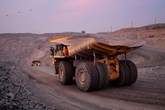Four Steps
Published by Jessica Casey,
Editor
Global Mining Review,
What does digital transformation mean and how should it be approached within the context of the mining industry? Fundamentally, digital transformation should be considered in terms of what will be delivered now and in the future. This includes the collection of data, enabling analysis, supporting decision making, providing an infrastructure for automation and enabling a safer environment.
Underground mines present unique challenges for technology-based infrastructure. Constraints include: the physical environment; the options for configuration and its resulting impact on performance and cost and the adaptability requirements of a dynamic environment.
In addition to this, the rapid expansion and development of Internet of Things (IoT) is resulting in rapidly evolving technologies that appear in the industrial environment at almost consumer paced development times. With no clear leader in communication protocols, what should those responsible for the selection of this technology think about?
Step one: why consider digital transformation?
The first question is: is a transformation needed? This is not simply a technological challenge – it is an investment decision like any other. Therefore, the same reasoning, justification and decision-making processes should be used as for any other business transformation, and so the following questions can be asked:
- Does the future of an underground mine require systems to handle larger amounts of data, higher volumes of communication, faster decision making and more automation than currently exists?
- Who within the operations needs access to this enhanced platform and what will they need to do with it?
- Does the business have the knowledge internally to get where they want to be or do they need a technology partner?
- How do you make a start?
Step two: approaching digital transformation
Assuming that the first round of questions draws the conclusion that a digital transformation project is needed, there is a further set of questions that can be considered, such as:
- How will this transformation improve the output to the complete chain from supplier to customers and all other stakeholders?
- Will the transformation assist operations to increase output, reduce waste and improve overall efficiency?
- Will the transformation positively impact all people – making work safer and more rewarding, as well as providing better communications, enabling better decision-making and promoting greater collaboration?
- What processes are the mines striving to improve with an enhanced digital platform? Is it communication, people tracking, material movement, equipment tracking and health, remote blasting, data for short interval control, remote control and automation, for example?
- What department will benefit from this transformation? Mine management, operations, processing, technical services, maintenance, human resources, logistics or procurement?
- What are the impacts on the existing infrastructure? Cabling systems, fibre optics, power supplies, interfaces with existing control systems, personnel communications and tracking equipment?
- What communications methods are the mine likely to need in the future – WiFi, BLE, Leaky Feeder, RFID, Bluetooth, LoRa, UWB and LTE or any combination?
Step three: where to start?
The starting point is to answer the previous questions as completely as possible before reviewing the proposed solution as holistically as possible within the context of the unique situation and environment. Then consider how the physical infrastructure, existing and future communications equipment, peripheral devices and overarching software need to integrate. Finally, assume that different types of wireless communication solutions and their associated sensors and controls will emerge within the desired lifetime of the infrastructure. Also ensure that the return on investment can be met by evolving the new infrastructure to accommodate these new protocols, not replacing it.
Read the article online at: https://www.globalminingreview.com/special-reports/11082020/four-steps/
You might also like
Lumwana expansion in full swing as Barrick builds Tier One copper mine
Construction of the Super Pit Expansion Project at Barrick Mining Corp.’s Lumwana mine is well underway, accelerating its transformation into a Tier One copper mine.


